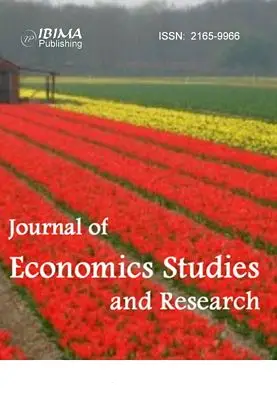Introduction
The quarantines decreed by governments during the COVID-19 pandemic, as a measure to protect and mitigate the spread of the virus in Colombia, led some companies of all sizes and economic activities, including those in tourism, to leave the market or decrease their activity, which affected their income, the level of employment and the economic activity of the country, especially in sectors such as tourism. (Universidad de los Andes, 2020; National Association of Travel and Tourism Agencies [ANATO], s. f.). Given this impact, the National Government provided support and incentives for the tourism sector, given that it was one of the most affected in the first months of the pandemic (Ministry of Commerce, Industry and Tourism [MINCIT], 2020a). In the case of Ráquira, Alcaldía Municipal de Ráquira (2020) shows that the impact was very negative in terms of a significant decrease in its income from tourism and handicrafts.
To get out of this crisis in a sector like handicrafts, it was important to modernize production processes and marketing to cushion the negative effects of the crisis in this economic sector, since after five months with total restrictions, economic recovery. In the tourism sector (which is related to crafts in Ráquira), it happened slowly (MINCIT, 2020, b). However, seeking other types of strategies such as access to the benefits of the orange economy is important to improve economic results and strengthen companies. The problem with the above is that there is a lack of knowledge of the foundations of the orange economy and the potential benefits it has for those economic activities that are included in this sector, which is why this document will first present the theoretical bases that underpin it. Additionally, this document will study some of the characteristics of the orange economy in Colombia, identifying the contribution of this sector to national production, in the tourism and handicrafts sectors.
The last section presents the methodology used in this research and the results that were obtained through the application of surveys and interviews carried out with the artisans of the municipality of Ráquira, where it was found that there is a lack of knowledge of the benefits of the orange economy for artisans, which has prevented them from accessing these benefits. Likewise, the great interest in receiving training through various means such as brochures, courses (virtual and in person), social networks, television and radio was evident, and thus being able to take advantage of the benefits of the orange economy, for the handicrafts and tourism sector, as part of the national cultural heritage.
Theoretical Foundations of the Orange Economy
According to Buitrago & Duque (2013), there are several related concepts that refer to the types of economic activities that produce goods and services that involve intellectual, cultural, and even ancestral components with the potential to improve the income and well-being of populations. Creativity, understood as the ability to produce goods and services from the generation of new ideas, helps to drive economic development (Núñez y Riveiro, 2023), especially for vulnerable population groups that have cultural and intellectual wealth, and the economic agents in these sectors should be encouraged to be more productive and take advantage of their benefits (González Beuses, 2020). Taking into account connotations of this type, Buitrago & Duque (2013) call this creative economy the Orange Economy, since it is a color that connotes creativity and innovation. Figure 1 highlights examples of successful businesses that generate millions in income and that belong to the orange economy.
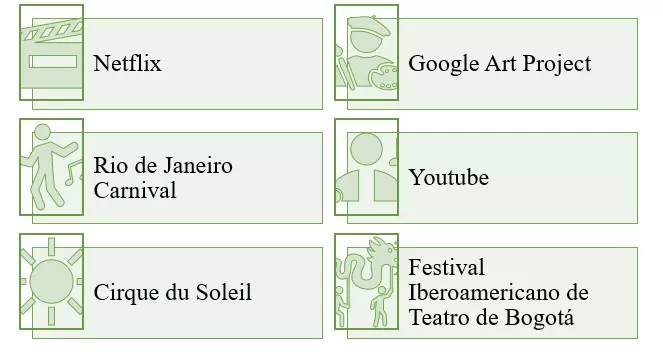
Fig 1. Successful companies and events that belong to the orange economy
Prepared by the author based on Buitrago & Duque (2013)
Overview of the Orange Economy in Colombia
In Colombia, according to the regulations of Law 1834 (2017), three large sectors are involved in the production of creative goods: visual and performing arts, handicrafts, audiovisuals, design, new media; and creative services: architecture, culture and recreation, research and development and advertising. It also includes creative industries, cultural industries, and arts and heritage, from which other economic activities are derived. From the latter it can be said that both handicrafts and tourism are part of the Arts and Heritage sector of the creative industry, which according to the Colombian Orange Law includes. The crafts sector includes (Figure 2) and the tourism and cultural heritagesector includes (Figure 3):
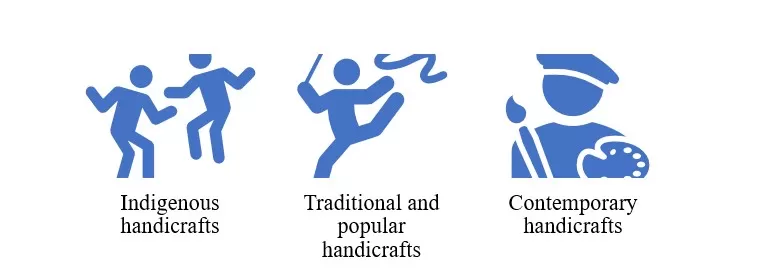
Fig 2. Handicrafts sector
Prepared by the author based on Ministerio de Cultura, (n.d.).
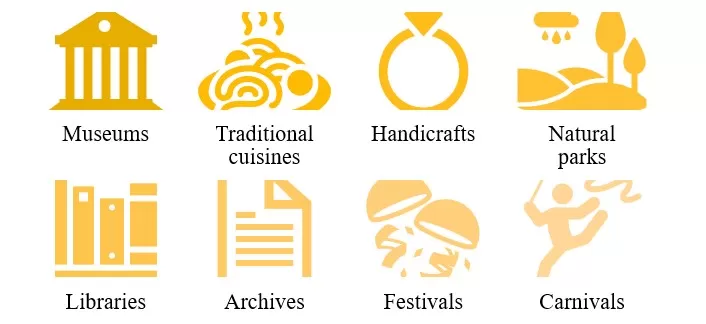
Fig 3. Tourism and cultural heritage sector.
Prepared by the author based on Ministerio de Cultura, (n.d.).
the following (Law 1834/2017):
- Education: SENA, DNDA, Ministry of Culture, Ministry of Education.
- Support, incentives and financing: National Guarantee Fund, Ministry of Information Technology and Communications, SENA, Findeter, Ministry of Culture, Bancoldex, INNpulsa, Proimágenes Colombia, Ministry of Science.
- Guidance and technical assistance: Artesanías de Colombia, Ministry of Trade, Industry and Tourism, Colombia Productiva, Procolombia, Superintendence of Companies, INNpulsa, Bancoldex, DNDA, Ministry of Information Technology and Communictions, Superitendece of Industry and Commerce.
- Knowledge: Ministry of Information Technology and Communictions, Ministry of Eduction, Superintendence of Companies.
Contributions of the Orange Economy
The Orange Economy makes a major contribution to GDP, as measured on the supply side, since, according to DANE statistics (2022), this sector has contributed to the country’s economic activity between 2.6% and 3.3% of the total GDP between 2014 and 2021. This means that it generates jobs and requires the formation of human capital, which not only comes from educational institutions but is also derived from the transmission of knowledge from generation to generation. The problem lies in measuring its contribution to the development and improvement of living conditions for the populations and economic sectors involved in this area. Riascos et al. (2020) highlight the handicraft sector as an opportunity to drive economic growth in the regions where it is performed in Colombia.
At the international level, Saldaña et al. (2018) show the successful role of handicrafts in promoting tourism and improving sales revenues in Mexico. According to the United Nations Conference on Trade and Development (UNCTAD, 2008), one way to promote inclusive and sustainable development in developing countries is to seek and adapt technology and culture as drivers for economic and social development, through the consumption of cultural goods represented in symbols, pictorial representations, writings, music and sounds typical of each region. By uniting culture, creativity, technology, innovation and the economy, the necessary conditions can be created to increase the creative sector’s contribution to GDP, generating jobs for populations that are otherwise excluded, while promoting racial and cultural diversity. As shown by Lalangui et. al. (2017), a sustainable tourism that contributes to the environment is characterized by the promotion of greater social justice, respect for the environment, and the improvement of the economic well-being of populations. Regarding the environment, Figueroa (2013) points out that economic development can take place as long as there is a balance between caring for the environment and the production of goods and services.
On his part, Garay (2018) points out that in general for any country, the orange economy provides an opportunity for economic growth, increasing jobs based on producing goods and services derived from the intellect and creativity. For this, it is necessary to have institutions responsible for the regulation and promotion of the sectors that are part of the creative economy (Segura, et. al., 2021), in which the creative industries “comprise the cycle of creation, production and distribution of goods and services that use intellectual capital as their primary input” (UNCTAD, 2008, p. 56).
In the case of Colombia, since the administration of Iván Duque Marquez (2018 -2022), laws and institutions have been promoted, aimed at driving the industries that belong to the orange economy, such as the issuance of Law 1834/2017, which aims to “promote, encourage and protect Colombian creative industries and grant them greater relevance in the national economy.” Peña and Vargas (2018) point out that a factor that can improve the performance and contribution made by the creative economy to Colombia’s GDP would be an increase in foreign investment, as well as training and an increase in the country’s human capital, to complement what has been done out so far in this area. According to DANE (2022), the contribution made by the orange economy to the added value of GDP, from 2014 to 2022, on average has ranged between 2.6% and 3.3%, as shown in Figure 4:
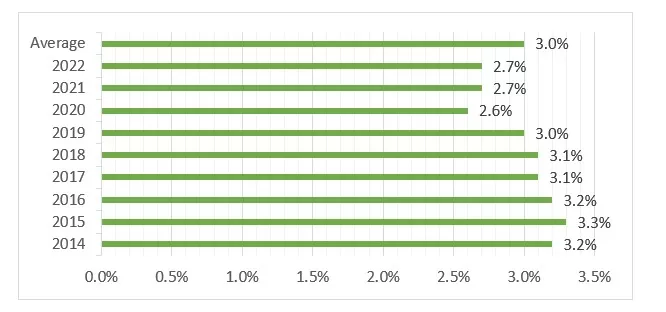
Fig 4. Percentage contribution of the orange economy to the added value of the national economy.
Prepared by the author based on DANE (2023).
This contribution from the orange economy is important, despite the fact that most companies are not formally structured, given that they are classified as microbusinesses, taking into account the criteria cited by DANE (2022), as displayed in Figure 5:
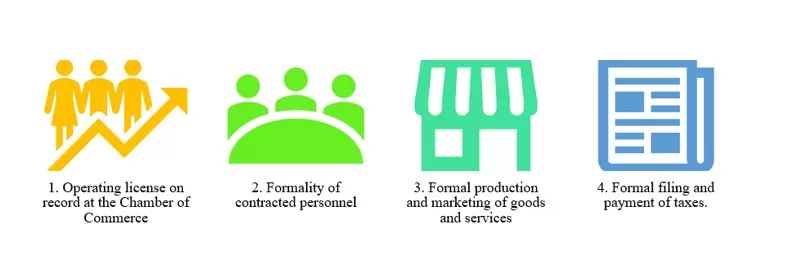
Fig 5. Characteristics of formalization in artisan microbusinesses
Prepared by the author based on DANE (2023)
Table 2. Figures regarding the formality of microbusinesses involved in the orange economy in 2022. Prepared by the author based on DANE (2023)
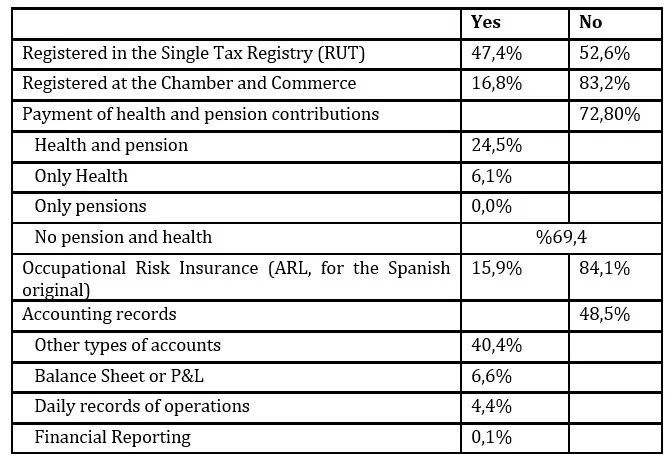
As shown in Table 2, not all microbusinesses in Colombia involved in the orange economy have been formalized, and, on the contrary, most are operating empirically in a manner that does not guarantee the best conditions for owners and employees, without carrying any accounting records and financial analysis that would allow them to improve their economic results in the short, medium, and long term. Segura & Sarmiento (2020) show that financial education for microentrepreneurs from all economic sectors is a necessary requirement for the owners of such businesses, who are both managers and employees of their establishments.
Methodology
This study is descriptive in scope with a quantitative approach, aimed at inquiring with the target population (artisans of the municipality of Ráquira) how they could benefit from the orange economy, as a possible strategy for the growth and expansion of their activities, as long as they have knowledge about the subject. The entire process was carried out in the following four phases, as displayed in Figure 6:
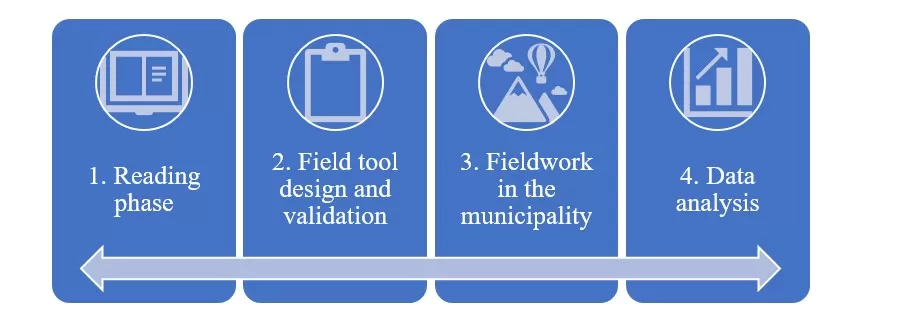
Figure 6. Phases of the Study
Prepared by the author
Phase 1. Literature review
Review of national and international information sources, based on the definitions of creative economy and orange economy, where the main input is human intellect, to then show how it works in Colombia and the benefits it offers to the companies in this sector.
Phase 2. Field tool design and validation
To obtain the information, an interview form was designed based on the main findings of phase 1 and the characteristics of the target population observed in secondary information sources. The form was validated by subject matter experts.
Phase 3. Fieldwork in the municipality
Surveys were applied to 40 artisans of the municipality who are located in handicraft commercial establishments. The survey was structured by modules: the first module sought to characterize the target population; the second module characterizes the economic activity and the way it is carried out; and a third module seeks to know whether or not the artisans are aware of the orange economy benefits offered in Colombia.
Phase 4. Data analysis
Based on the data collected, a descriptive analysis was made of the main variables that affect having or not having knowledge about the orange economy, and whether the target population has made use of these benefits.
Results and Discussion
The benefits of the orange economy as an economic and social development strategy offer both economic and other types of benefits that positively affect enterprises and companies that have access to them, through mechanisms such as training, support, and technical assistance provided by the entities in charge of providing them (Ministry of Culture, n.d.). The main finding, based on the application of the surveys and interviews with the target population in the field, was that the population was conceptually and empirically unaware of the orange economy and its possible benefits. After learning about the positive effects, it could have on their businesses, they raised questions and displayed interest in learning more about the subject.
As can be seen in Figure 7, only 15% of the respondents said they knew that handicrafts are part of the creative (orange) economy, and only 10% said they were aware of the benefits available for this economic activity. The most concerning finding is that none of the respondents said they have received any of the potential benefits of the orange economy. Figure 8 shows some of the orange economy benefits available for artisans, which 10% of the respondents are aware of:
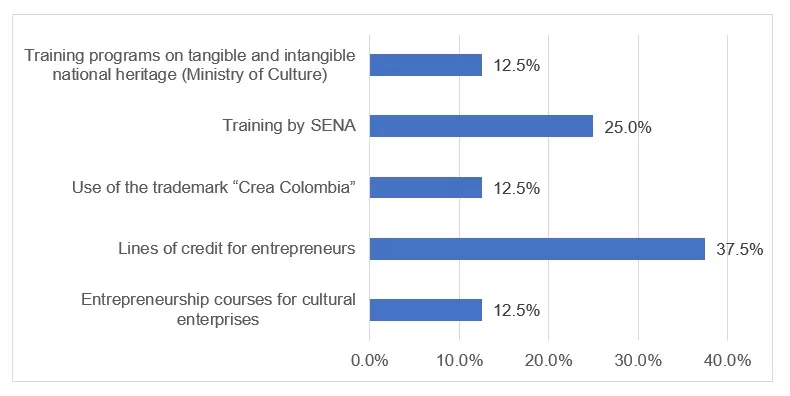
Fig 8. Knowledge about the Orange Economy benefits
Prepared by the author
Based on the dialogues held with the artisans and the answers to the interviews, the respondents indicated how they would like to receive information about the orange economy, its programs, institutions and benefits, as summarized in Figure 9. It should be noted that brochures and virtual training programs already exist, but the respondents are not aware of them, such as the Orange Economy ABC handbook published on the website of the Ministry of Culture.

Fig 9. Desired methods for learning about the benefits of the orange economy
Prepared by the author
It should be clarified that despite the ignorance of the benefits of the orange economy for artisans, they are aware of the contribution that this ancestral activity makes to the local and regional economy, since, when asked about this aspect, they said that it contributes to the development of tourism and economic development, recognition of the regional culture, job creation, generation of livelihoods and work for future generations, and to driving the economic recovery in post-pandemic times. This ignorance may have compounded the negative results on this activity in this municipality at the time of the pandemic, since they all said they were affected by the closures and measures taken by the national government, producing decreases in income and even losses, as can be seen in Figure 10. Only 5% of them said they were able to maintain their income.
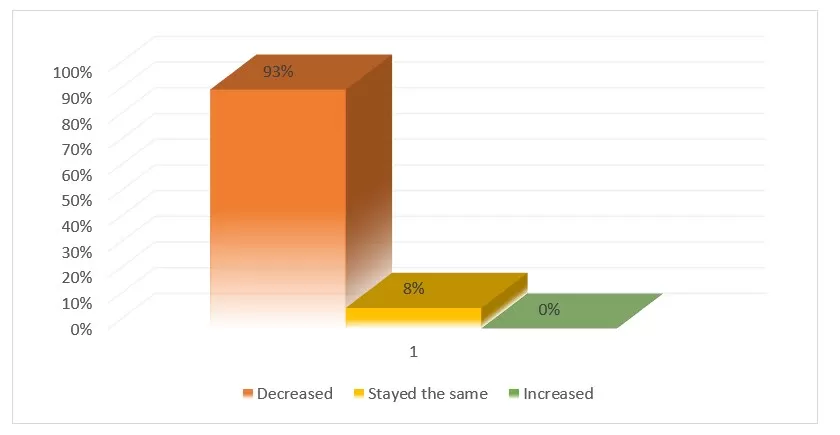
Fig 10. Change in the artisans’ income during the pandemic. Prepared by the author (2022)
Faced with these negative impacts, artisans had to fend for themselves with whatever knowledge they had, and search for strategies to mitigate these impacts, such as selling their products at lower prices (24%), marketing online and through social networks (22%), digital marketing (7%). However, 48% said they had not taken any action. The national government provided economic assistance to some of the sectors belonging to the orange economy through decree 475/2020, but the artisans of Ráquira reported that they had not received any aid, since, as shown by Segura et. al. (2021), it was mostly targeted at activities related to performing arts and other sectors, whereas handicrafts were not included.
For this group of entrepreneurs and other microentrepreneurs, it is important to stabilize their income and increase competitiveness by developing and implementing a strategic process that prepares them for critical situations such as the global pandemic that took place in 2020 (Padilla et al., 2021), as well as the use of new technologies (Leyva et al., 2021).
Conclusions
With this research, it was found that 85% of the artisans surveyed do not know that crafts are part of the orange economy, 90% do not know about their benefits and 100% have not been beneficiaries of these, although the orange economy and its benefits could be of great help to microentrepreneurs who are dedicated to the noble work of craftsmanship in the municipality of Ráquira, a town trapped in time in terms of its architecture, but in the process of modernization and searching for strategies to attract more tourism to improve sales of their products, not only in person, but through other non-physical means which began to be used massively after the COVID-19 pandemic. Through the fieldwork carried out in the municipality, it was observed that the orange economy and its potential benefits are of great interest to the artisans, and that local authorities could jointly schedule training days on the subject, to raise their awareness of these benefits through talks, brochures and audiovisual material.
Despite the negative impact of the COVID pandemic on the income and well-being of the artisans of the municipality, it was observed that they continue with their economic activity and are interested in improving their production and marketing processes, though without setting aside their traditions. This allows this artisan activity to subsist over time and continue to contribute to the local, regional, and national economy, by creating jobs and improving the quality of life of the people of Ráquira. Other businesses dedicated to tourism, such as hospitality, gastronomy, and transportation in the municipality, depend on visitors who travel to the village to delight their eyes with the beautiful handicrafts, and take them to their homes for aesthetic purposes to create beautiful atmospheres.
References
- Alcaldía Municipal de Ráquira Boyacá, (2020). Se decretan medidas de contención y acciones de prevención para contrarrestar el COVID-19 en el municipio de Ráquira-Boyacá. http://www.raquira-boyaca.gov.co/noticias/se-toman-medidas-para-contrarrestar-el-covid19-en-el
- Asociación Nacional de Agencias de Viajes y Turismo [ANATO], (s. f.). Resumen Normativo Gobierno Nacional COVID-19. https://anato.org/resumen-normativo-gobierno-nacional-covid-19/
- Buitrago, F., and Duque, I. (2013). The orange economy: An infinite opportunity. https://publications.iadb.org/es/publications/english/viewer/The-Orange-Economy-An-Infinite-Opportunity.pdf
- Congreso de Colombia, (23, mayo de 2017). Ley 1834, ley naranja. Congreso de Colombia. https://www.suin-juriscol.gov.co/viewDocument.asp?ruta=Leyes/30030647
- Departamento Administrativo Nacional de Estadística [DANE]. (2023). Noveno reporte de Economía Naranja. https://www.dane.gov.co/files/operaciones/CSECC/inf-CSECC-IXReporte-jun2023.pdf
- Figueroa, A. (2013). Crecimiento económico y medio ambiente. Naciones Unidas, CEPAL. https://repositorio.cepal.org/items/93ece202-4d2c-4f16-b362-acb53033ed08
- Garay, S. (2018). Economía naranja colombiana en tiempos modernos. Ploutos, 7(2), 34-41. https://journal.universidadean.edu.co/index.php/plou/article/view/1873
- González Beuses, A. G. (2020). Economía del siglo XXI: economía naranja. Revista de ciencias sociales, 26(4), 450-464. https://www.redalyc.org/journal/280/28065077033/html/
- Lalangui, J., Espinoza Carrión, C. R., and Pérez Espinoza, M. J. (2017). Sustainable tourism, a contribution to the corporate social responsibility: the beginning, characteristics and development. Universidad y Sociedad [seriada en línea], 9 (1), pp. 148-153. http://scielo.sld.cu/scielo.php?script=sci_arttext&pid=S2218-36202017000100021
- Leyva, A., Heredia, J. A., and Aguilar, P. (2020). El Emprendimiento como estrategia en tiempos de crisis. Revista de Investigación Académica Sin Frontera: Facultad Interdisciplinaria de Ciencias Económicas Administrativas-Departamento de Ciencias Económico Administrativas-Campus Navojoa, (35), 1-36. https://revistainvestigacionacademicasinfrontera.unison.mx/index.php/RDIASF/article/view/407
- Ministerio de Cultura, (n.d.). ABC de la Economía Naranja. https://www.mincultura.gov.co/prensa/noticias/Documents/atencion-al-ciudadano/_ABC_ECONOMÍA_NARANJA_.pdf
- Ministerio de Comercio, Industria y Turismo [MINCIT], (2020a). Decretos y otras medidas frente a la crisis sanitaria COVID-19. https://www.mincit.gov.co/prensa/medidas-para-mitigar-impacto-del-covid-19/infografias/abece-decretos-y-medidas-frente-a-covid-19-03abr20.aspx
- Ministerio de Comercio, Industria y Turismo [MINCIT], (2020b). Abecé sobre reactivación del sector turismo. https://www.mincit.gov.co/prensa/noticias/turismo/abece-sobre-reactivacion-del-sector-turismo
- Núñez, E., and Riveiro, M. (2023). Relación entre el comercio de artesanías y el sector turístico en Imbabura-Ecuador: consideración desde la planificación y promoción institucional. Revista Espacios, 44(09). https://www.revistaespacios.com/a23v44n09/a23v44n09p12.pdf
- Padilla Buñay, A., Lluglla Luna, L. A., Álvarez Arboleda, W. R., and Ramírez Rodríguez, B. E. (2021). Crisis y reactivación turística en tiempos de covid-19. Cámara de turismo provincia de Pastaza. Revista Universidad y Sociedad, 13(3), 426-434. http://scielo.sld.cu/scielo.php?pid=S2218-36202021000300426&script=sci_arttext
- Riascos, J. C., Acosta, L. F., and Ortiz, M. I. (2020). Economía naranja y la actividad artesanal en Colombia y Nariño: una breve revisión analítica. Tendencias, 21(2), 218-241. http://www.scielo.org.co/scielo.php?script=sci_arttext&pid=S0124-86932020000200218
- Saldaña-Ortega, O. A., Serrano-Barquín, R. D. C., Pastor-Alfonso, M. J., and Palmas Castrejón, Y. D. (2018). Análisis interpretativo del impacto del turismo en el patrimonio cultural artesanal. Tepoztlán, México. https://rua.ua.es/dspace/handle/10045/84548
- Segura, J., and Sarmiento, V. J. (2020). Effects of Financial Crises on Latin American Economies-Colombia Case and the SMEs. Econ. Stud. Res, 808445. https://ibimapublishing.com/articles/JESR/2020/808445/808445.pdf
- Segura, J., Rodríguez, J. and Alarcón, G. (2021). Systemic application and its impact on artisans in Colombia in the face of the crisis generated by COVID-19 as an activity belonging to the orange economy. Revista Ibérica de Sistemas e Tecnologias de Informação, (E44), 132-142. https://dialnet.unirioja.es/servlet/articulo?codigo=8668399
- United Nations Conference on Trade and Development, (2008). Trade and development report 2008. https://unctad.org/system/files/official-document/tdr2008_en.pdf
- Universidad de los Andes, (2020). Turismo: la turbulencia causada por la pandemia. https://uniandes.edu.co/es/noticias/turismo-en-turbulencia-continua-por-el-aislamiento



